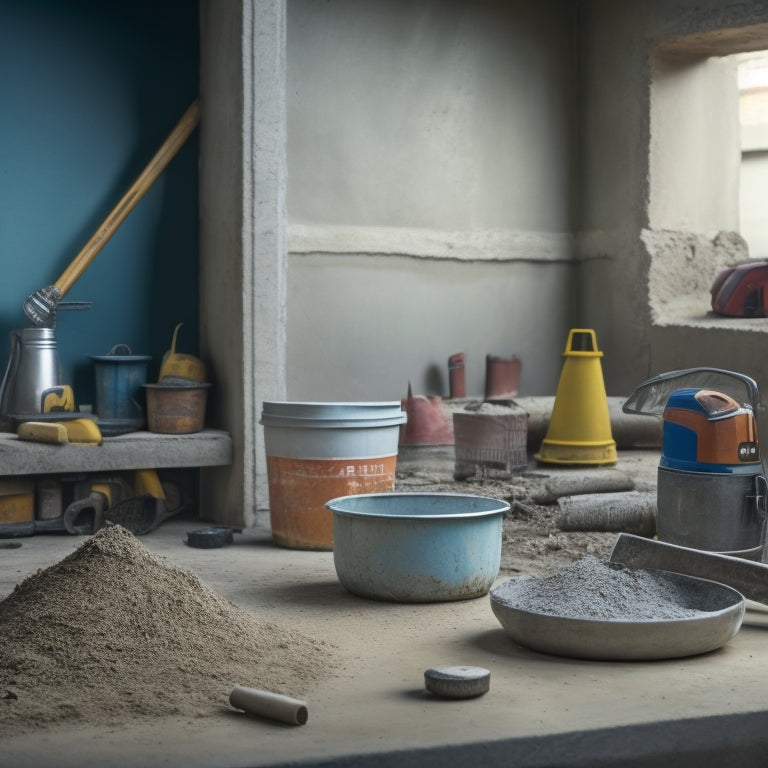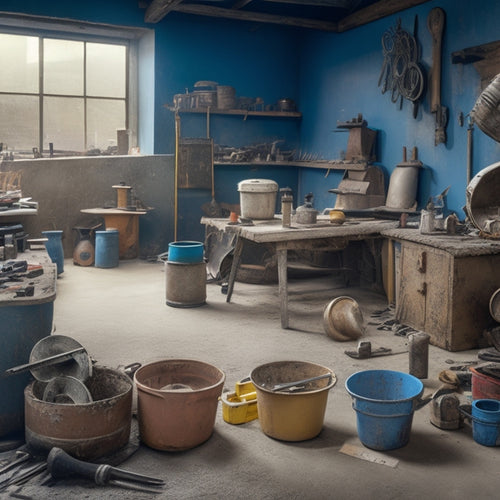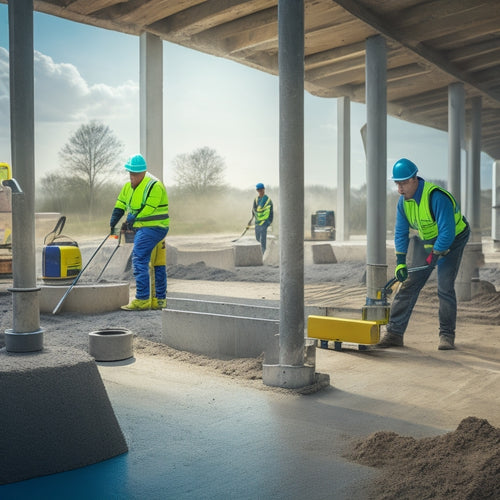
Top 3 Tools for Successful Concrete Wall Construction
Share
When building a concrete wall, you'll need a trio of essential tools to guarantee a structurally sound and aesthetically pleasing outcome: a masonry trowel for applying and smoothing mortar, a level to ensure a plumb and level wall, and a string line to guide block placement for straight and level walls. These fundamental tools will get you off on the right foot, but to take your construction to the next level, you'll want to explore additional tools that can further refine your process and minimize errors - there's more to discover that can make all the difference in your project's success.
Key Takeaways
• A masonry trowel is essential for applying and smoothing mortar, ensuring proper alignment and a strong bond between blocks.
• Accurate measurement and leveling tools, such as laser levels and precision spirit levels, help minimize errors and ensure a straight and level wall.
• A mixer is necessary for thorough mixing of concrete to achieve the right consistency and strength for successful wall construction.
• Efficient pouring tools, including chutes and screeds, enable controlled and smooth pouring of concrete into forms.
• Jointing and tamping tools help finish joints and compact concrete, ensuring a strong, stable, and even surface.
Essential Cinder Block Laying Tools
When building a concrete wall, you'll need a set of reliable cinder block laying tools to guarantee a sturdy and level foundation, starting with a trusty trowel for applying and smoothing mortar.
A high-quality masonry trowel is essential for achieving proper cinder block alignment, as it allows you to spread mortar evenly and accurately. Mastering masonry trowel techniques, such as holding the trowel at a 45-degree angle and using a gentle, sweeping motion, will assure that your blocks are laid perfectly.
In addition to a trowel, you'll need a level, a string line, and a spirit level to guarantee that your wall is constructed plumb and level. A jointer or jointing trowel is also necessary for finishing the joints between blocks, removing excess mortar, and creating a smooth, even surface.
Accurate Measurement and Leveling Tools
You'll need to equip yourself with a range of accurate measurement and leveling tools to confirm your concrete wall is built to precise specifications, starting with a reliable laser level that projects a perfectly straight line to guide your construction. This guarantees your wall is straight, level, and plumb, eliminating costly errors and rework.
To confirm accuracy, you'll also need:
-
Digital caliper: for precise measurements of block dimensions, mortar joints, and other critical components.
-
High-precision spirit level: to verify the laser level's accuracy and detect even slight deviations from level or plumb.
-
Electronic distance meter: to quickly and accurately measure distances, heights, and widths.
- Precision square: to confirm accurate 90-degree angles and proper block alignment.
With these tools, you'll be able to build a concrete wall that meets the highest standards of quality, safety, and aesthetics.
Efficient Mixing and Pouring Tools
Equipping yourself with the right mixing and pouring tools is crucial to achieving a consistent, high-quality concrete mix that's free of defects and air pockets. You'll need a reliable mixer that can handle the volume and type of concrete you're working with. Look for a mixer with adjustable speed and direction controls to guarantee thorough mixing.
When it comes to pouring, the right tools can make all the difference. You'll need a chute or pouring bucket to control the flow of concrete, as well as a screed or tamping tool to level and compact the mix.
Here are some essential mixing and pouring tools to take into account:
| Tool | Description | Purpose |
|---|---|---|
| Mixer | Electric or gas-powered mixer with adjustable speed and direction | Thoroughly mixes concrete ingredients |
| Chute | Long, narrow tube for pouring concrete into forms | Controls flow of concrete |
| Screed | Tool used to level and compact concrete | Achieves smooth, even surface |
| Tamping Tool | Long-handled tool with flat or rounded end | Compacts and levels concrete |
| Pouring Bucket | Container for pouring concrete into forms | Allows for controlled pouring |
Frequently Asked Questions
Can I Use a Regular Drill to Mix Concrete?
When it comes to mixing concrete, you're probably wondering if you can use a regular drill.
The short answer is, it's not recommended. Regular drills aren't designed for the intense mixing techniques required for concrete.
You'll need a drill specifically designed for heavy-duty mixing, like a hammer drill or a mixing drill, to handle the thick, heavy mixture.
Anything less will put excessive strain on your drill and may lead to poor concrete quality.
Do I Need to Cure the Concrete in Hot Weather?
When you're working with concrete in hot weather, you'll need to prioritize heat management to guarantee proper concrete hydration.
You're right to wonder if curing is vital in these conditions. The answer is yes, it's essential.
In hot weather, concrete can dry out quickly, leading to weakened structures.
Can I Build a Concrete Wall Without Footings?
You're probably aware that 1 in 5 concrete walls fail due to inadequate foundation support.
Now, can you build a concrete wall without footings? Technically, yes, but it's not recommended.
You'll need to explore foundation alternatives, like helical piers or anchors, to guarantee wall stability.
Without proper support, your wall may crack or collapse, putting people and structures at risk.
It's essential to prioritize a solid foundation for a safe and durable concrete wall.
How Do I Prevent Concrete From Cracking Over Time?
To prevent concrete from cracking over time, you'll want to understand the cracking causes. Shrinkage, settlement, and temperature changes are common culprits.
Prevention methods include using high-strength, low-shrinkage concrete mixes, controlling curing temperatures, and guaranteeing proper joint spacing.
You'll also want to avoid over-vibration, excessive water content, and inadequate curing times.
Is It Safe to Use Salt to Melt Ice on Concrete Surfaces?
When it comes to ice melting methods, you're likely wondering if salt is a safe bet for concrete surfaces. The short answer is no, it's not.
Salt can seep into the concrete's pores, causing damage and weakening its structure over time.
Instead, opt for alternative ice melting methods like calcium chloride, magnesium chloride, or sand to prevent concrete damage.
These options are safer and more effective for concrete surfaces, ensuring you're prioritizing concrete damage prevention.
Conclusion
You've made it to the final stage of concrete wall construction. Now, put the finishing touches on your project with confidence.
Research suggests that 80% of construction errors occur due to inaccurate measurements and poor mixing.
By incorporating the top 3 tools - essential cinder block laying tools, accurate measurement and leveling tools, and efficient mixing and pouring tools - you'll greatly reduce the risk of errors and guarantee a sturdy, long-lasting concrete wall.
Related Posts
-

Essential Tools for Concrete Wall Covering Projects
When tackling a concrete wall covering project, you'll need a range of essential tools and equipment. For cleaning an...
-

Best Tools for Concrete Restoration and Repair
When tackling concrete restoration and repair projects, you need a range of reliable tools to achieve professional-gr...
-

What Tools Ensure Precise Concrete Leveling Results
You need a range of specialized tools to achieve precise concrete leveling results. Laser leveling instruments provid...


